Eufy Dual Video Doorbell Review 2025
A high-tech doorbell with unique features — but are two cameras really better than one?

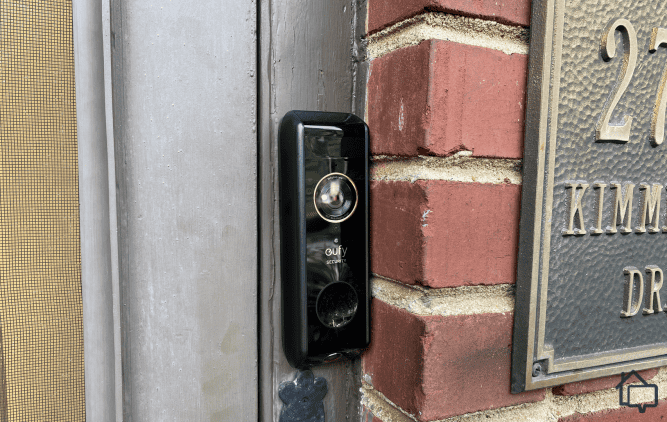
SafeHome.org may receive compensation from some providers listed on this page. Learn More
We may receive compensation from some providers listed on this page. Learn More
A high-tech doorbell with unique features — but are two cameras really better than one?


Folks are always innovating in the security space, and let me just say — I’m here for it. Sometimes these innovations can be a little gimmicky, but other times, I’m left with my mouth hanging open, wondering why hasn’t anyone thought of that before?
That’s how I felt when I was testing the Eufy Dual Video Doorbell. Also going by the less descriptive name “Eufy S330,” this doorbell camera packs in features I’ve never seen before and couples them with best-in-class technology to offer one of the better video doorbells I’ve ever worked with. It’s great for package detection, porch-pirate prevention, and burglar deterrence.
Why? Well because it has two cameras.
It’s not called the “dual” for nothing. With one forward-facing camera and one downward-facing, you’re going to be able to see everything going on — from pedestrians passing by to packages delivered right up against your door. The Eufy (allegedly) misses nothing.
We’re going to get into this as well as all of the ins and outs in just a bit, but first, let’s go through a quick list of pros and cons to get our bearings.
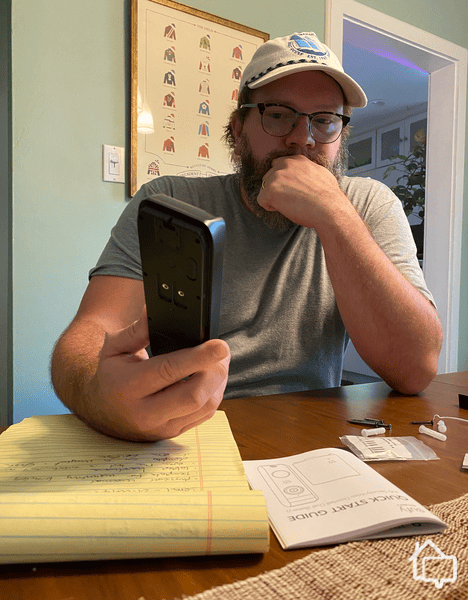
Getting ready to test the Eufy Dual Video Doorbell.
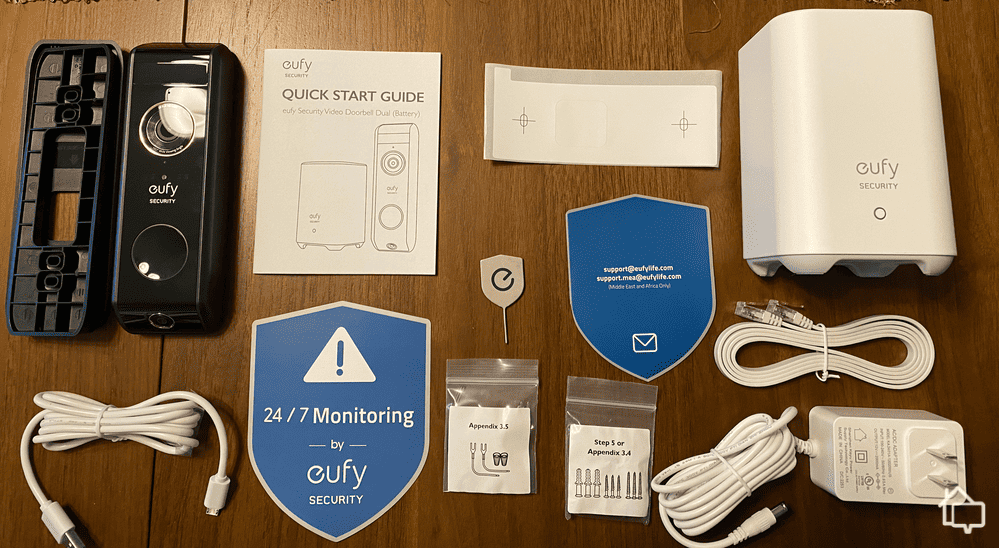
Everything that comes in the Eufy Dual box.
So far, so good. As you can see, there are a lot of features here that are reminiscent of what I saw in my review of the Google Nest Doorbell — another one of my favorites — namely the 2K resolution and the facial recognition.
Pro Tip: You’ll have to add your recognized faces to your Eufy database using your app. It’s a simple process, but that’s how it learns.
Not only can the Eufy tell the difference between the delivery guy and passing trucks, it will also get to know your family and friends who frequent your home thanks to its onboard AI. I’m getting ahead of myself, though. Let’s talk about my initial impressions first.
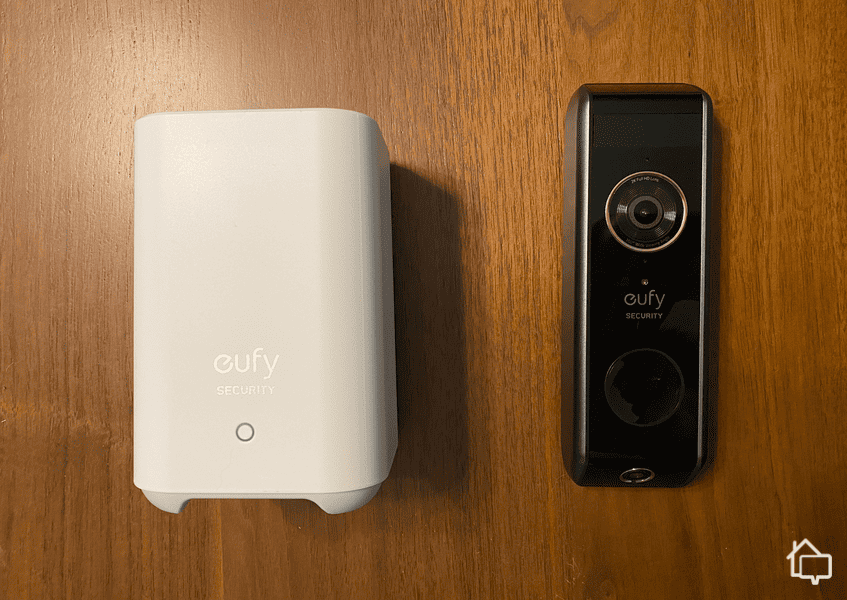
The Eufy Dual Video Doorbell and the Home Unit.
The very first thing I have written in my notebook is “attention to detail.” This doorbell just nails user experience from the second you take it out of the box. Not only is it packaged elegantly, everything you need is right where you’d expect it to be. The hardware is all labeled, and they have a detailed physical instruction manual, which I always appreciate — hey, call me old school.
And, get this, the removal key is magnetized, so you can stick it on your fridge instead of immediately losing it in your junk drawer and using a screwdriver to pry the thing off your wall when it’s time to recharge it. Nice touch here, Eufy.

Eufy Dual’s magnetized removal tool stuck to my fridge.
So nice job on the details, but another immediate impression that I got was that the unit and the base station are both a little… shall we say… hefty? I’m always looking for my electronics to be sleek and slender, but the Eufy feels like you could take it off the wall and beat a burglar over the head with it. That isn’t to say it’s not well designed, mind you … it’s just a little big.
So once everything was out of the box, though, I was ready to get it set up to test everything out. Here’s what that process looked like:
Check out more recommendations from the SafeHome team:



Setting up and installing the Eufy Dual is a relatively easy process, but there are three distinct parts to it. I’ll go through them all here, in order.
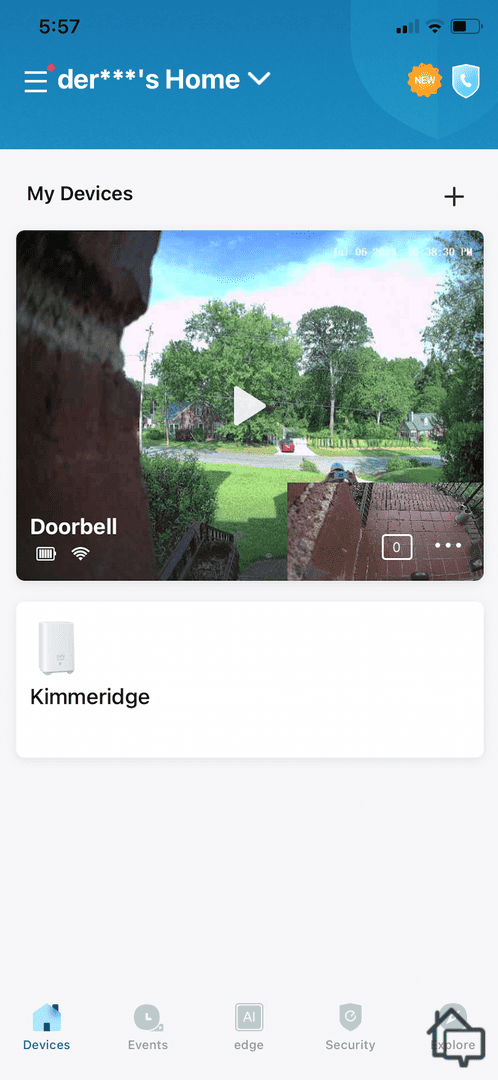
The Eufy app home screen.
Head over to the app store and download the Eufy app. There’s nothing to this, really. You’ll just need to set up an account if you don’t have one. The app is really easy to use and super intuitive during this process as well as once you have the equipment up and running. It reminded me a little of Arlo’s app in that sense — that one is also really easy to use and well-designed.
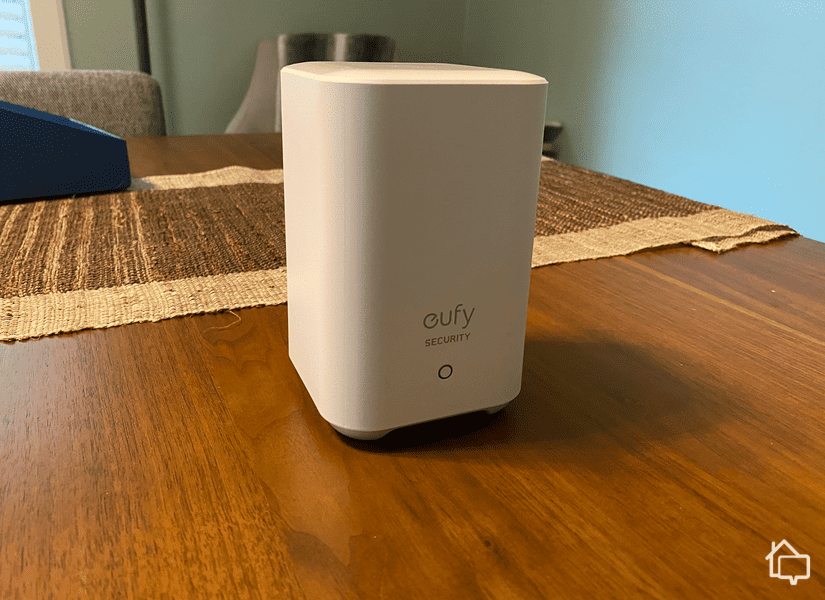
The Eufy Home Base sitting on my dining room table.
So this is an interesting thing about the Eufy ethos. They really don’t trust cloud storage, and with all of the breaches making headlines every couple of weeks, who could blame them? So instead of making you sign up — and pay for — a cloud subscription, they provide you with the Home Base. I’ve seen this in a few home security systems before, but never with a standalone video doorbell. Local storage without a subscription? This is a major selling point for Eufy. Once you purchase the equipment, you’re not going to need to pay a monthly fee to make it work properly. Bonus points in my book.
Pro Tip: When you’re setting up the Home Base, make sure it’s up on a desk or table. It’ll also get better connectivity if it’s not right up against a wall. Also consider the walls your Wi-Fi signal is going to be passing through. Drywall is okay, but too many structural walls can give you connectivity problems.1
The Home Base is essentially the access point your doorbell camera will work off of and where it will store all of the data it records. The home base has 16 gigs of storage and will automatically overwrite your oldest recordings when it gets to capacity.
Setting it up is a breeze. Following the instructions on the app, you plug it into your router using the provided ethernet cord, plug the power into the wall, and hit the sync button. An automated voice will also tell you to do that, and after the firmware updates, it’ll announce it’s ready to go. Also note that this is where the “ding dong” from the doorbell will be played, so you might want to be thoughtful about where you place it.
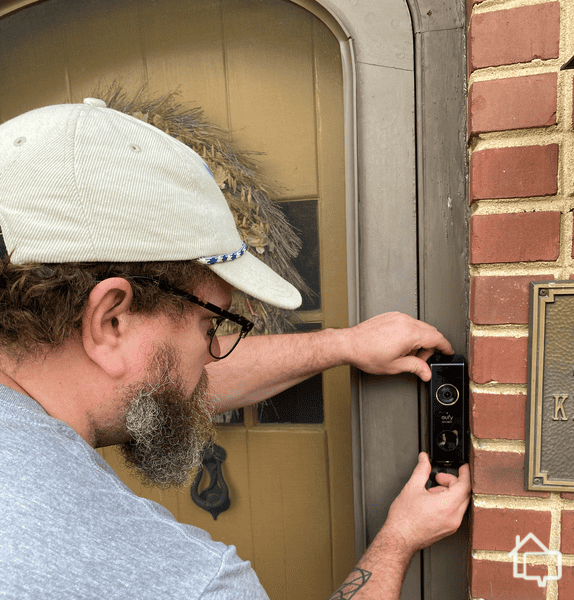
Mounting the Eufy Dual Video Doorbell on my front door.
Once your home base is set up, you’ll want to add the doorbell using the app. This is as simple as tapping “add device,” scanning the QR code on the back of the unit, then using the unit to scan a QR code generated in the app. Download a little firmware, and you’re all set. Now on to the installation.
The installation itself is very easy and consists of five steps:
At the end of the day, this took me about 15 minutes total. Two notes on the installation process, though:
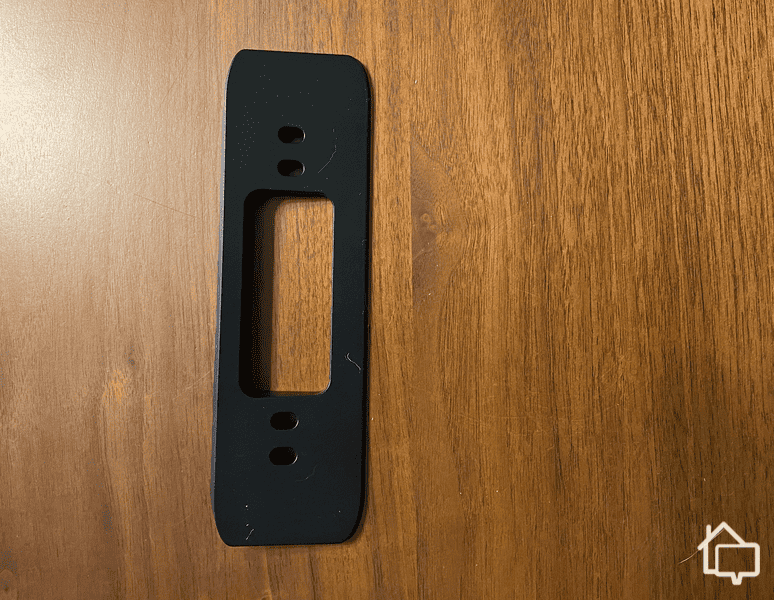
Eufy’s plastic mounting bracket.
I have to say it — I’m not a huge fan of the plastic bracket. It feels like it could be pretty easily broken by a thief, or it might snap if you get a little too overzealous when you’re drilling. That didn’t happen to me, but I do much prefer the metal bracket I got with my Google Nest Doorbell. Small potatoes? Probably. Worth pointing out? Yes.
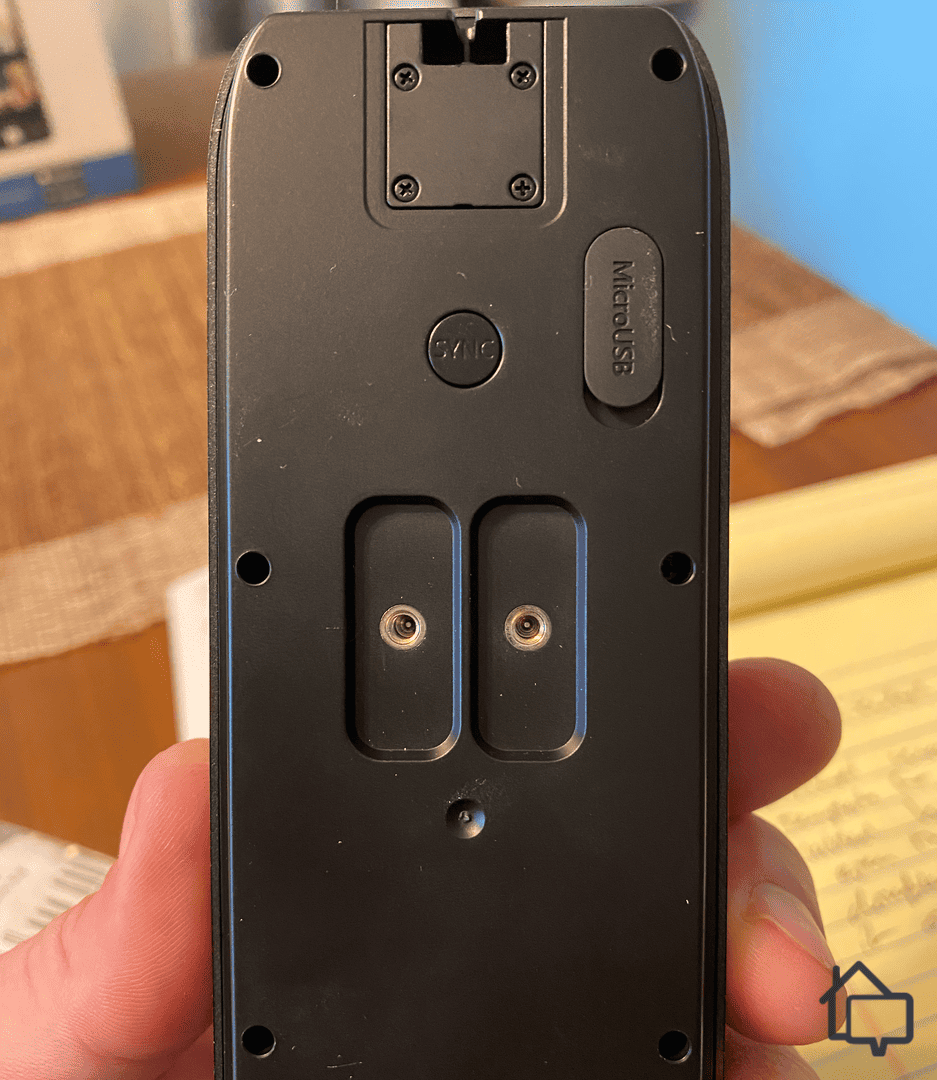
These are the leads where you’d attach your home’s doorbell wiring.
The Eufy Dual can actually be hardwired for continuous power if you have a legacy doorbell in your house, or you can run it off the battery. I opted to go for battery power, but it’s worth pointing out that you do have options. Under normal circumstances, Eufy claims one charge will last about six months.
Pro Tip: That six months figure really depends on the sensitivity settings you choose and how much traffic the doorbell is picking up. If you’re finding that you’re having to recharge your battery all the time, you can adjust the sensitivity so that it’s not recording every passing car or branch blowing in the wind.2

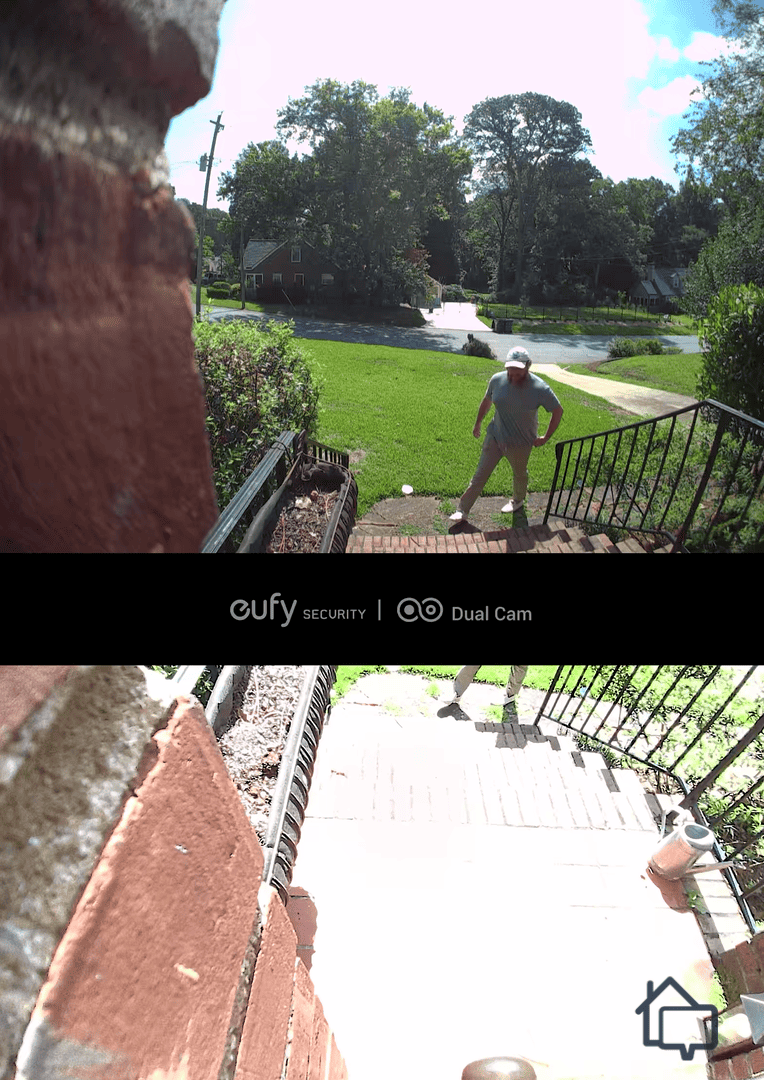
Video test of the Eufy Dual Video Doorbell on my front porch.
So overall, I want to say that I was pretty impressed with how the Eufy Dual performed. Its Primary 160-degree 2K video captured everything it needed to in stunning clarity, and the downward-facing, 97-degree,1080p package camera was able to see parcels no matter where they were tossed. Aside from the no-fee posture Eufy takes, I have to say this is absolutely the second biggest selling point of the Dual.
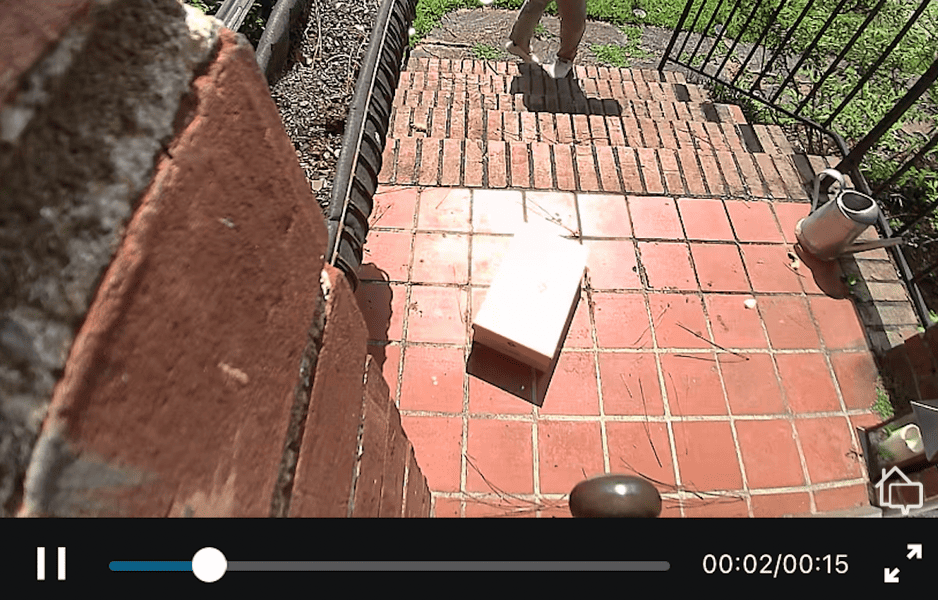
The downward-facing camera eliminates blind spots packages can hide in.
Before I tested the Eufy Dual, I would have said the two-camera thing is a gimmick. After using it for an extended time, though, I have to say I’m a believer.
One thing I’ve noticed with some video doorbells is that there’s a pretty significant blind spot directly under them. I noticed it with Ring, and I noticed it with Google Nest. That means if the Amazon guy tosses your package too close to your door, there’s a good chance you’re not going to know about it. That downward-facing camera on the Dual has zero blind spots, though. As you can see in the above image, that’s my doorknob. It’s looking right up against my house.
Pro Tip: Make sure you’re installing the unit at a height where the downward-facing camera will capture the entirety of the area below it. I found the sweet spot was about 4 to 5 feet for my doorway.
This dual camera feature is obviously the biggest differentiator when it comes to the Eufy Dual, but it’s far from the only feature this doorbell offers. Even without the package camera, this is one of the most advanced video doorbells I’ve worked with. Why? Namely it’s enhanced person and package detection.
A lot of security cameras and video doorbells these days boast “AI alerts” or even “facial recognition,” when what they really mean is “you’ll get an alert if a car goes by or if a guy walks up to your door.” Eufy, on the other hand, learns who people are and can tell you who’s approaching your door, so you’ll know instantly if it’s your husband coming home from work, your babysitter coming up the path, or a package thief up to no good.
It also has loitering detection so you can tell if it’s just a jogger going by or someone lurking a little too long near your property. And as I mentioned above, there’s a package camera with detections that will tell you when something was delivered and received.
Pro Tip: Looking to compare Eufy to some other popular brands? Check out our review of the Ring video doorbell as well as our hands-on guide to SimpliSafe’s video doorbell.
Eufy also offers a feature called delivery guard that will protect your packages while you’re away. If someone approaches a delivered package, the doorbell will play a prerecorded response — I recommend “stop, you’re being recorded,” and it will also send alerts to your phone reminding you to bring in your packages. Pretty cool stuff, but we can’t end here. I do have to bring up a few of this camera’s drawbacks.
While this doorbell camera checks a lot of boxes, there are a few places where it misses the mark. The first is its night vision.
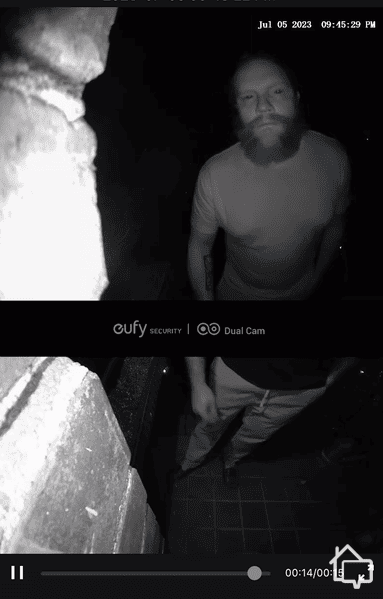
Eufy Dual night vision
Put simply, I’ve seen better. It’s not that it doesn’t get the job done, but for the money, I would have liked to see some enhancements here. Color night vision is pretty standard now on higher-end pieces of equipment like this — like some of Ring’s more expensive models — and I’d like to see that in newer models. Just something to think about, Eufy.
Pro Tip: Color night vision works by using advanced sensors that are capable of picking up more ambient light than traditional ones. The data they collect passes through an algorithm that enhances the color of what you see.3
When I was testing the Eufy Dual, I noticed there was a bit of lag in its ability to pick up events. If I walked by it multiple times back to back, it occasionally missed one of the passes. I was able to make things a little better by altering my motion detection settings, but I could still get it to miss events if I moved quickly. This might not be a huge deal for most people, but if you live in a high-traffic area — like a condo complex, for instance — you might want to consider it.
Pro Tip: The closer your Home Base is to the doorbell, the better your connectivity will be.
Other than these two factors and the minor things like the plastic mounting bracket I mentioned above, there wasn’t much else to find fault with in the Eufy Dual. Overall, it’s a solid piece of equipment with some really unique features you’re not going to find anywhere else. But this brings us to the final, ultimate question. Is it worth the money?
When I purchased the Eufy Dual from a third-party retailer, it was an eye-popping $282.74. Right now, the same kit is available on their website for $259.99. Still, that’s definitely on the pricey side for video doorbells. The only one I can think of that’s more expensive is the Ring Video Doorbell Elite, which is currently going for $349.99. So are these all the gadgets and gizmos offered by the Eufy Dual worth it?
Value is a subjective thing, so I can’t answer that question definitively. What I will say, though, is that you’re not going to find a cheaper video doorbell that offers the same features as the Eufy Dual. If what I’ve described above — the two-camera technology, the super-high resolution, and the advanced AI features — are all make or breaks for you, you’re going to be looking at spending about this much money. And it will likely be on this doorbell. If you can take or leave some of the more high-end tech and settle for less, you can definitely find a great video doorbell that’ll get the job done for less money.
It isn’t going to have that cool downward-facing package camera, though.
We spend hours and hours putting video doorbells through a demanding series of hands-on tests, but the process actually starts before the equipment is in our hands. We conduct exhaustive research on manufacturers to make sure they’re up to our standards. Only then do we install them in our own homes to see what it’s like living with them day-to-day to give you our honest insights, experiences, and recommendations.
While Eufy does offer professional monitoring for a monthly fee, the Dual does not require a monthly subscription for storage or advanced features.
Yes, not only does the Dual recognize the difference between different types of objects, it can learn the faces of your family members and friends and alert you to their presence.
Depending on where you purchase the equipment from, the Dual and Home Base cost between $250 and $300.
While it might not be a household name, Eufy has a great reputation in both the home security and cleaning spaces.
The Eufy Dual offers some of the most advanced technology in the industry as well as unique features like a downward-facing package camera that make it a great choice for most homeowners.
Mistral. Dos and Don’ts of Wi-fi connectivity: Maximizing Range and Reception.
https://www.mistralsolutions.com/articles/dos-donts-wi-fi-connectivity-maximizing-range-reception/
Eufy. (2023). Make Your Battery Doorbell Last Longer.
https://support.eufy.com/s/article/Make-Your-Battery-Doorbell-Last-Longer-1617357655394
Montavue. (2023, Feb 8). Advanced Night Vision Technologies – A Comprehensive Guide.
https://montavue.com/blogs/news/night-vision-technologies-a-comprehensive-guide?gc_id=18225136727&gclid=Cj0KCQjw8NilBhDOARIsAHzpbLCNKqRGXwQ0PgeUi97syxkZPWznYAX_71w5_oLf2afwfnb7oqbN_6UaAqkwEALw_wcB